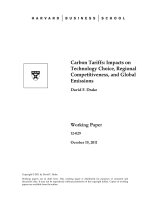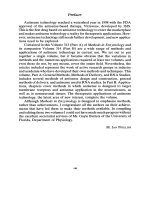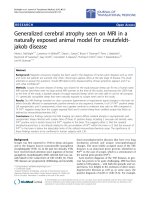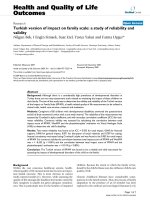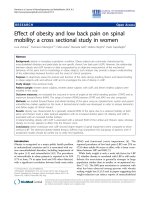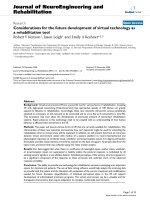Program-on-Technology-Innovation-A-Superconducting-DC
Bạn đang xem bản rút gọn của tài liệu. Xem và tải ngay bản đầy đủ của tài liệu tại đây (4.99 MB, 252 trang )
Program on Technology Innovation:
a Superconducting DC Cable
Program on Technology Innovation:
a Superconducting DC Cable
1020458
Final Report, December 2009
EPRI Project Manager
S. Eckroad
ELECTRIC POWER RESEARCH INSTITUTE
3420 Hillview Avenue, Palo Alto, California 94304-1338 • PO Box 10412, Palo Alto, California 94303-0813 • USA
800.313.3774 • 650.855.2121 • • www.epri.com
DISCLAIMER OF WARRANTIES AND LIMITATION OF LIABILITIES
THIS DOCUMENT WAS PREPARED BY THE ORGANIZATION(S) NAMED BELOW AS AN
ACCOUNT OF WORK SPONSORED OR COSPONSORED BY THE ELECTRIC POWER RESEARCH
INSTITUTE, INC. (EPRI). NEITHER EPRI, ANY MEMBER OF EPRI, ANY COSPONSOR, THE
ORGANIZATION(S) BELOW, NOR ANY PERSON ACTING ON BEHALF OF ANY OF THEM:
(A) MAKES ANY WARRANTY OR REPRESENTATION WHATSOEVER, EXPRESS OR IMPLIED, (I)
WITH RESPECT TO THE USE OF ANY INFORMATION, APPARATUS, METHOD, PROCESS, OR
SIMILAR ITEM DISCLOSED IN THIS DOCUMENT, INCLUDING MERCHANTABILITY AND FITNESS
FOR A PARTICULAR PURPOSE, OR (II) THAT SUCH USE DOES NOT INFRINGE ON OR
INTERFERE WITH PRIVATELY OWNED RIGHTS, INCLUDING ANY PARTY'S INTELLECTUAL
PROPERTY, OR (III) THAT THIS DOCUMENT IS SUITABLE TO ANY PARTICULAR USER'S
CIRCUMSTANCE; OR
(B) ASSUMES RESPONSIBILITY FOR ANY DAMAGES OR OTHER LIABILITY WHATSOEVER
(INCLUDING ANY CONSEQUENTIAL DAMAGES, EVEN IF EPRI OR ANY EPRI REPRESENTATIVE
HAS BEEN ADVISED OF THE POSSIBILITY OF SUCH DAMAGES) RESULTING FROM YOUR
SELECTION OR USE OF THIS DOCUMENT OR ANY INFORMATION, APPARATUS, METHOD,
PROCESS, OR SIMILAR ITEM DISCLOSED IN THIS DOCUMENT.
ORGANIZATION(S) THAT PREPARED THIS DOCUMENT
Advanced Energy Analysis
Cable Consulting International Limited
Electric Power Research Institute
Exponent Failure Analysis Associates
W2AGZ
NOTE
For further information about EPRI, call the EPRI Customer Assistance Center at 800.313.3774 or
Electric Power Research Institute, EPRI, and TOGETHER…SHAPING THE FUTURE OF
ELECTRICITY are registered service marks of the Electric Power Research Institute, Inc.
Copyright © 2009 Electric Power Research Institute, Inc. All rights reserved.
CITATIONS
This report was prepared by
Advanced Energy Analysis
1020 Rose Avenue
Piedmont, CA 94611
Exponent Failure Analysis Associates
149 Commonwealth Drive
Menlo Park, CA 94025
Principal Investigator
W. Hassenzahl
Principal Investigators
S. Nilsson
A. Daneshpooy
Cable Consulting International Limited
PO Box 1
Sevenoaks, Kent
TN14 7EN, UK
W2AGZ
1147 Mockingbird Hill Lane
San Jose, CA 95120
Principal Investigator
B. Gregory
Principal Investigator
P. Grant
Electric Power Research Institute (EPRI)
1300 West W. T. Harris Blvd.
Charlotte, NC 28262
Principal Investigator
S. Eckroad
This report describes research sponsored by EPRI.
The report is a corporate document that should be cited in the literature in the following manner:
Program on Technology Innovation: a Superconducting DC Cable. EPRI, Palo Alto, CA:
2009. 1020458.
iii
PRODUCT DESCRIPTION
Shortly after the beginning of the twentieth century, dc power transmission was replaced by ac in
order to achieve efficient transmission of electric power over long distances with available
conductors and at safe distribution voltages. However, dc power was not completely abandoned,
and the advent of solid-state power electronic ac-to-dc conversion equipment has reinvigorated
its application. High-voltage dc power is more desirable for long-range transmission than ac in
many ways: dc uses two wires rather than three, uses a simpler conductor, eliminates capacitive
elements to cancel inherent inductive behavior, and can use the earth as one of the currentcarrying elements. When justified by a lower cost per kilometer, dc transmission is now used for
long-distance, high-power transmission lines as well as for interconnecting asynchronous ac
systems.
Results and Findings
This report describes the design of an interregional, superconducting dc cable system that is
intended to achieve 10 GW power capacity with a nominal current and voltage of 100 kA and
100 kV. When installed, it will enhance the safety, reliability, and efficiency of the existing ac
power grid and enable a level of bulk power transfer that is not conceivable with today’s
conventional technology. Superconducting dc cable systems are inherently suitable for longdistance, high-power, bulk energy transfer without the disadvantages of either high-voltage dc or
extrahigh-voltage ac systems. The superconducting dc cable is projected to have greater
reliability and security, substantially lower losses, a smaller right-of-way footprint, fewer siting
restrictions, and the ability to be terminated at distribution voltages in or near load centers. An
underground superconducting dc cable system could transport many gigawatts of power from
remote energy farms (wind, hydropower, coal, or nuclear facilities) to urban load centers with
minimal impact on the environment. The superconducting dc cable will serve multiple,
distributed generators and loads, using voltage source converter–based technology for the power
on and off ramps.
Challenges and Objectives
The objectives of this program are to research, develop, and demonstrate a superconducting dc
cable system at a level suitable for use on an electric power grid. From the outset, a system
capable of being built with today’s technology was envisioned. In developing the design of the
superconducting dc cable, the research team relied heavily on existing, commercially available
cable, cryogenic, and superconductivity technologies. A challenge in the present design has been
to determine whether and where new approaches might be better than existing capabilities,
especially in light of the goal of producing a conceptual design than could realistically become
the basis for the final engineering design of a commercial prototype system within a five- to tenyear timeframe. Despite these challenges, the authors present an engineering-based design that
can be expected to function effectively as a new component of the power grid. The major
v
technical challenge for the future of this technology will be to test some of the novel concepts
using a model cable that has the full transverse dimension proposed, if not the full powercarrying capability at first.
Application, Value, and Use
This report provides insight into the groundbreaking research sponsored by the Electric Power
Research Institute (EPRI) on superconducting dc cable systems. It will provide utilities and
others with a basic understanding of the design concepts and the potential benefits of such a
system and a well-thought-out starting point for further engineering design and optimization
activities by both institutional research bodies and industrial organizations.
EPRI Perspective
In 2001, Dr. Chauncey Starr, founder and president emeritus of EPRI, introduced the concept of
the SuperGrid, a superconducting dc cable cooled by liquid hydrogen to link underground
nuclear power plants that would produce both the electricity and the hydrogen that flowed on the
dc cable. The nitrogen-cooled superconducting dc cable project described in this report is a first
step toward—but is considerably less ambitious in scope than—the SuperGrid. It must be
considered on its own merits, and it is viewed as having a nearer-term payoff that is independent
of the longer-term SuperGrid vision while still being supportive of it. In the present program, the
superconducting dc cable has been taken to a level of engineering design at which the team is
confident of the practicality of the concept and its readiness for commercial development.
In his welcome address to the first EPRI workshop on superconducting dc cables in October
2005, Dr. Starr described the values that determine “big systems” as the ability to provide energy
under difficult conditions, to avoid the enormous social costs of off-design events, and to move
huge amounts of power over long distances. He went on to say that the timeframe for the
development, application, and acceptance of the superconducting dc cable system would likely
be 20–30 years, as it has been for other major innovations in the power industry. It took 50 years
for the power industry to move from wood to coal; it took 10 years to develop advanced turbines
and another 10 years for them to be accepted. We do not expect that this project will be an
exception. However, EPRI has historically been a leader in innovative transmission cable design
work, including the initial development of superconducting ac cables, and considerable progress
has now been made in developing the conceptual design of a superconducting dc cable.
Approach
In 2005, EPRI held a workshop on the technology of superconducting dc transmission cables in
order to bring together a small group of experts in technologies relevant to the development of
such a cable. The goals were to enumerate potential issues and technical challenges, to bring all
the participants to a fundamental level of familiarity with the various technologies, and to discuss
a timetable for development. Following that initial workshop, a team of researchers began a
three-year trek toward the development of a feasible superconducting dc cable design.
Keywords
Cryogenic systems
DC transmission systems
Green power transmission
vi
Superconductors
Superconducting dc cable
Voltage source converters
CONTENTS
1 INTRODUCTION AND SUMMARY ........................................................................................1-1
1.1
Historical Background ..................................................................................................1-1
1.2
The Superconducting DC Cable Program ...................................................................1-4
1.3
Report Outline..............................................................................................................1-7
2 AC GRID INTERFACE AND CABLE SYSTEM DRIVERS ....................................................2-1
2.1
Vision: Reinventing the North American Transmission System...................................2-1
2.2
Existing DC Links and Lines ........................................................................................2-3
2.3
Interaction of DC Cables and Lines with Ground.........................................................2-5
2.4
Converter Technology .................................................................................................2-5
2.5
The Superconducting DC Cable with Multiple Local Connections to the Grid .............2-7
2.6
Issues and Future Work on the Superconducting DC Cable .......................................2-9
3 SUPERCONDUCTORS: PAST, PRESENT, AND FUTURE..................................................3-1
3.1
General Properties of Superconductors.......................................................................3-1
3.1.1
Early Developments ............................................................................................3-1
3.1.2
The Bardeen-Cooper-Schrieffer Theory of Superconductivity ............................3-2
3.1.3
Type II Superconductors: Technically Useful Materials ......................................3-3
3.2
The High-Temperature Superconductors ....................................................................3-7
3.2.1
The Search for Higher-Temperature Superconductors.......................................3-7
3.2.2
Status of High-Temperature Conductors ............................................................3-9
3.2.2.1
Gen 1 Technology and Process..................................................................3-10
3.2.2.2
Gen 2 Technology.......................................................................................3-11
3.3
High-Temperature Superconductor Performance Targets for Cable Design.............3-11
3.4
Cable Losses Due to Time-Dependent Current Flow ................................................3-21
vii
4 CABLE DESIGN AND FABRICATION ..................................................................................4-1
4.1
Introduction ..................................................................................................................4-1
4.2
Background..................................................................................................................4-1
4.2.1
Conventional Cables ...........................................................................................4-2
4.2.2
Superconducting AC Cables ...............................................................................4-8
4.3
Superconducting DC Cable Design ...........................................................................4-11
4.3.1
Approach...........................................................................................................4-11
4.3.2
Conductor Mandrel............................................................................................4-13
4.3.3
Inner and Outer Quench Conductors ................................................................4-14
4.3.4
Inner and Outer Superconductor Layers...........................................................4-14
4.3.5
Conductor Shields.............................................................................................4-15
4.3.6
Insulation...........................................................................................................4-16
4.3.7
Outer Shield and Insulator ................................................................................4-16
4.3.8
Sheath and Skid Layer......................................................................................4-17
4.4
Superconducting DC Cable Dimensions....................................................................4-17
4.5
Superconducting DC Cable Fabrication.....................................................................4-19
5 VACUUM SYSTEM ................................................................................................................5-1
5.1
Introduction ..................................................................................................................5-1
5.1.1
Overview .............................................................................................................5-1
5.1.2
Heat Input............................................................................................................5-4
5.1.2.1
Heat Conduction by Residual Gas................................................................5-4
5.1.2.2
Thermal Radiation.........................................................................................5-5
5.1.2.3
Combined Radiation and Gaseous Convection ............................................5-6
5.1.3 Some Units Used in Vacuum Systems....................................................................5-7
5.2
Getters .........................................................................................................................5-7
5.3
Vacuum Pumps .........................................................................................................5-10
5.3.1
Purpose.............................................................................................................5-10
5.3.2
Types ................................................................................................................5-11
5.3.3 Pumping Speeds and Pressure Drop ....................................................................5-12
5.4
Superconducting DC Cable Vacuum Issues..............................................................5-14
5.4.1
Conductance and Pressure Drop in a Vacuum System....................................5-14
5.4.2
Residual Gas, Outgassing, and Leaks..............................................................5-15
5.4.2.1
viii
Water Vapor and the Need for Purging with a Dry Inert Gas......................5-15
5.4.2.2
Leaks ..........................................................................................................5-16
5.4.2.3
Impact of Cryogenic Surface on Gas Adsorption and Freezing ..................5-17
5.4.3
5.5
Superconducting DC Cable Vacuum Pump Capacity and Spacing ..................5-17
Conclusions and Observations ..................................................................................5-18
5.5.1
Comparison of These Results to the Previous Study........................................5-18
5.5.2
Issues for the Next Stage of Vacuum System Design ......................................5-18
6 CRYOGENICS........................................................................................................................6-1
6.1
Introduction and Summary...........................................................................................6-1
6.1.1
Introduction .........................................................................................................6-1
6.1.2
Summary.............................................................................................................6-2
6.2
6.1.2.1
Refrigerator Station Separation ....................................................................6-3
6.1.2.2
Initial Temperature of the Cryogen ...............................................................6-3
6.1.2.3
Temperature Rise Along the Cable Between Refrigerator Stations..............6-3
6.1.2.4
Maximum Pressure Drop Between Refrigerator Stations .............................6-3
Heat Flow into the Cold Mass ......................................................................................6-5
6.2.1
Radiation and Conduction Through the Vacuum ................................................6-5
6.2.2
Heat Conduction Along Mechanical Supports.....................................................6-6
6.2.3
Losses Associated with the Flow of the Cryogen................................................6-8
6.2.4
Heat Generated Within the Cable Conductors..................................................6-10
6.2.5
Heat Input at the Vacuum and Refrigerator Stations ........................................6-11
6.2.6
Heat Flow Through the Power Leads................................................................6-12
6.2.7
Summary of Heat Inputs ...................................................................................6-14
6.3
Cryogen Flow.............................................................................................................6-14
6.3.1
Practical Cable Flow and Tube Dimensions .....................................................6-17
6.3.2
Effect of Altitude Changes.................................................................................6-19
6.3.3
Temperatures During Normal Operation...........................................................6-20
6.3.4
Counterflow Heat Exchange .............................................................................6-21
6.4
Refrigerator Separation Issues ..................................................................................6-24
6.4.1
Case 1, Urban or Suburban Environment .........................................................6-25
6.4.2
Case 2, Rural Environment ...............................................................................6-26
6.4.3
Case 3, Mountainous Environment ...................................................................6-26
ix
7 END STATIONS AND CONVERTERS ..................................................................................7-1
7.1
Converter Topology .....................................................................................................7-1
7.2
Superconducting Cable System Assumptions .............................................................7-2
7.3
Converter Station Design.............................................................................................7-5
7.4
Grounding of the Superconducting Cables ................................................................7-10
7.5
Energization of the DC System..................................................................................7-13
7.6
Further Research and Development Needs ..............................................................7-14
8 FABRICATION AND INSTALLATION ...................................................................................8-1
8.1
8.1.1
Vacuum Pipe.......................................................................................................8-2
8.1.2
Cleaning Vacuum Pipe and Installing Internal Reflective Coating ......................8-4
8.1.3
Cryogenic Enclosure and Return Pipe ................................................................8-4
8.1.4
Cryogenic Supports.............................................................................................8-5
8.1.5
Multilayer Insulation ............................................................................................8-5
8.1.6
Getters ................................................................................................................8-6
8.1.7
Factory Welds .....................................................................................................8-7
8.1.8
Instrumentation ...................................................................................................8-8
8.1.9
Installation of Collar and Protective End Caps....................................................8-8
8.2
Field Fabrication and Final Assembly ..........................................................................8-8
8.2.1
Site Preparation ..................................................................................................8-8
8.2.2
Transportation ...................................................................................................8-10
8.2.3
Positioning in Trench.........................................................................................8-10
8.2.4
Welding of Cryogenic Pipes and Connecting Instrumentation ..........................8-12
8.2.5
Welding Collars to Connect the Vacuum Pipe ..................................................8-13
8.3
x
Factory-Fabricated Components .................................................................................8-2
Vault and Manhole Installation...................................................................................8-13
8.3.1
Cable Pulling .....................................................................................................8-15
8.3.2
Cable Splicing ...................................................................................................8-18
8.3.3
Vacuum Pump Installation and Pumpdown ......................................................8-22
8.3.4
Vacuum and Cryogenic Component Sectioning ...............................................8-23
8.3.5
Cryogenic Station Installation............................................................................8-23
9 FUTURE WORK .....................................................................................................................9-1
9.1
System Test .................................................................................................................9-1
9.2
Cryogenics and Vacuum..............................................................................................9-2
9.3
Insulation and Dielectrics .............................................................................................9-2
9.4
Cable Design and Fabrication......................................................................................9-5
9.5
Converters ...................................................................................................................9-5
9.6
Grid Interface ...............................................................................................................9-6
9.7
Optimization and Tradeoffs..........................................................................................9-7
9.8
Costs............................................................................................................................9-8
9.9
Superconductors..........................................................................................................9-8
9.10
General ...................................................................................................................9-9
10 REFERENCES ...................................................................................................................10-1
A ABBREVIATIONS AND ACRONYMS .................................................................................. A-1
B SYSTEM STUDY OF LONG-DISTANCE LOW-VOLTAGE TRANSMISSION USING
HIGH-TEMPERATURE SUPERCONDUCTING CABLE ......................................................... B-1
C ECONOMIC CONSIDERATIONS ......................................................................................... C-1
xi
LIST OF FIGURES
Figure 1-1 Cable cross section ..................................................................................................1-6
Figure 2-1 Single-phase, two-level voltage source converter ....................................................2-7
Figure 2-2 A simplified, six-node drawing of the superconducting dc cable as connected
to various parts of the ac grid.............................................................................................2-8
Figure 3-1 A replication of the original observation of zero resistance in mercury in 1911........3-2
Figure 3-2 A simplified view of the interaction between a phonon and a lattice in the
Bardeen-Cooper-Schrieffer theory .....................................................................................3-3
Figure 3-3 Phase diagram of a typical type II superconductor...................................................3-4
Figure 3-4 Illustration of the vortex dynamics of a type II superconductor.................................3-5
Figure 3-5 The irreversibility line................................................................................................3-6
Figure 3-6 Origin of ac hysteretic losses in a type II superconductor ........................................3-7
Figure 3-7 Observed increase in TC since 1911.........................................................................3-8
Figure 3-8 The two categories of high-temperature superconductor tapes currently
available ...........................................................................................................................3-10
Figure 3-9 The two principal methods of manufacturing Gen 2 high-temperature
superconductor tape ........................................................................................................3-12
Figure 3-10 Dependence of the critical current, JC, of Gen 2 YBCO on the magnetic field
(data from SRL-ISTEC, Japan) ........................................................................................3-14
Figure 3-11 Effect of various pinning impurities on the anisotropy of JC with respect to the
direction of applied magnetic field (data from Los Alamos National Laboratory) .............3-15
Figure 3-12 Comparison of IC per unit tape width of representative samples ..........................3-16
Figure 3-13 Variation of IC per unit width as a function of the direction of a 1-T externally
applied field with respect to the tape plane (a-b)..............................................................3-17
Figure 3-14 Specification sheet for American Superconductor copper-stabilized Gen 2
tape ..................................................................................................................................3-18
Figure 3-15 E-J characteristic, typical of both Gen 1 and Gen 2 .............................................3-19
Figure 3-16. Representative Fourier decomposition of rectified current from a general
purpose n-phase passive rectifier ....................................................................................3-22
Figure 4-1 Cable transport drum, fully loaded with cable...........................................................4-2
Figure 4-2 Loaded cable transport drums being transported from manufacturing facility to
installation site....................................................................................................................4-3
Figure 4-3 A 400-kV ac cable with extruded, solid insulation (left) and oil-impregnated
paper insulation (right) .......................................................................................................4-4
Figure 4-4 A tape-lapping machine in a humidity-controlled enclosure .....................................4-5
xiii
Figure 4-5 One of the tape-lapping heads .................................................................................4-5
Figure 4-6 Layout of a horizontal extrusion machine for cable insulation ..................................4-6
Figure 4-7 An extruded cable core emerging from the extrusion and cross-linking
machine..............................................................................................................................4-7
Figure 4-8 Triple extrusion equipment in a vertical line. The conductor appears as a
vertical, white line to the left of the foremost extrusion press.............................................4-7
Figure 4-9 A warm dielectric, single-phase superconducting ac cable ......................................4-8
Figure 4-10 A superconducting triplex with nitrogen-impregnated, cold insulation
between phases .................................................................................................................4-9
Figure 4-11 Three cold-dielectric, superconducting, single-phase ac cables in a single
pipe ..................................................................................................................................4-10
Figure 4-12 Superconducting dc cable design.........................................................................4-13
Figure 4-13 Conductor stranding machine...............................................................................4-19
Figure 5-1 Simplified design for cryogenic and vacuum calculations ........................................5-2
Figure 5-2 Design of the cable developed for the EPRI report System Study of LongDistance Low-Voltage Transmission Using High-Temperature Superconducting
Cable..................................................................................................................................5-3
Figure 6-1 Cable in pipe envelope showing various components..............................................6-4
Figure 6-2 Temperature increase along the superconducting dc cable (base case) .................6-8
Figure 6-3 Pressure drop along the superconducting dc cable for the flow of liquid
nitrogen ..............................................................................................................................6-9
Figure 6-4 Pressure drop along the superconducting dc cable for the flow of supercritical
nitrogen ..............................................................................................................................6-9
Figure 6-5 Temperature along a warm-to-cold power lead for different operating currents.....6-13
Figure 6-6 Saturation pressure of liquid nitrogen over the operating range.............................6-15
Figure 6-7 Saturation density variation of liquid nitrogen over the operating range.................6-15
Figure 6-8 Pressure-specific volume diagram for liquid nitrogen .............................................6-16
Figure 6-9 Pressure drop along the cryogenic enclosure as a function of tube diameter ........6-18
Figure 6-10 Pressure drop along the return tube as a function of tube diameter.....................6-19
Figure 6-11 Pressure changes in a 10-km length of cable with an altitude change of
150 m ...............................................................................................................................6-20
Figure 6-12 Nominal temperature rise along the superconducting dc cable............................6-21
Figure 6-13 Hypothetical example of counterflow heat exchange in a constrained flow
loop ..................................................................................................................................6-22
Figure 6-14 Temperatures along the superconducting dc cable for medium heat transfer......6-23
Figure 6-15 Temperatures along the superconducting dc cable for good heat transfer ..........6-24
Figure 7-1 Switching arrangement to transfer converter A from a failed to a healthy
cable; similar switches would be required on converter B..................................................7-3
Figure 7-2 Single-phase, two-level voltage source converter ....................................................7-5
Figure 7-3 Output voltage from a single-phase, two-level pulse-width modulation
converter ............................................................................................................................7-6
xiv
Figure 7-4 Three-phase, two-level voltage source converter.....................................................7-7
Figure 7-5 Switched phase-to-phase output voltage and fundamental ac component for
the three-phase, two-level voltage source converter..........................................................7-8
Figure 7-6 Ripple current through the capacitor at no load........................................................7-9
Figure 7-7 Highly simplified superconducting cable design .....................................................7-12
Figure 7-8 Cable in pipe envelope showing various components............................................7-13
Figure 8-1 Simplified design of factory-assembled pipe for superconducting dc cable .............8-2
Figure 8-2 Example of gas pipeline being delivered to site in preparation for welding ..............8-9
Figure 8-3 Artist’s concept for truck transport of pipe sections for the superconducting dc
cable.................................................................................................................................8-10
Figure 8-4 Side view of two pipe sections for the superconducting dc cable that are
nearly in place ..................................................................................................................8-11
Figure 8-5 Diagonal view of two pipe sections for the superconducting dc cable that are
nearly in place ..................................................................................................................8-11
Figure 8-6 After the vacuum pipe of the left section is in place, the two cryogenic pipes
are welded together by an automatic welder. ..................................................................8-12
Figure 8-7 The final step in installing a section of cable is welding the collar to both pipe
sections. ...........................................................................................................................8-13
Figure 8-8 Artist’s concept of the vault with the two vacuum pipes installed ...........................8-14
Figure 8-9 Vacuum vault with vacuum pump installed and an extended section of pipe.........8-15
Figure 8-10 Extensions of the cryogenic enclosure to accommodate cable pulling and
joint fabrication .................................................................................................................8-15
Figure 8-11 Cable pull for a superconducting cable ................................................................8-16
Figure 8-12 The superconducting dc cable core in place and ready to be pulled into the
cryogenic enclosure .........................................................................................................8-17
Figure 8-13 Cable cores extending into a vault in preparation for splicing ..............................8-17
Figure 8-14 The electrical splice for the superconducting dc cable .........................................8-18
Figure 8-15 The cable core......................................................................................................8-19
Figure 8-16 A completed splice ...............................................................................................8-21
Figure 8-17 Vault for vacuum and cable splice after full installation ........................................8-22
Figure 8-18 Vault for refrigeration and vacuum .......................................................................8-24
Figure 8-19 Cryogenic refrigerator and the associated vault for cryogenics and vacuum. ......8-24
Figure 8-20 Pumping station for a natural gas pipeline ...........................................................8-25
xv
LIST OF TABLES
Table 4-1 Dimensions of the various layers of the superconducting dc cable..........................4-18
Table 6-1 Design parameters of the superconducting dc cable.................................................6-4
Table 6-2 Weights of materials in the cold mass of the superconducting dc cable....................6-7
Table 6-3 Summary of heat inputs...........................................................................................6-14
xvii
1
INTRODUCTION AND SUMMARY
Economic, environmental, and political forces will change the nature of energy distribution and
use in the next decades. As a result, future electricity generation and consumption is quite
uncertain. Increased use of large generating facilities such as remote nuclear power plants or
huge wind farms forms one possibility, and small distributed energy sources such as renewable
and hydrogen sources form another. Should large, 5–10 GW power generation facilities become
the norm in a couple of decades, methods of transmitting power of this level over long distances
will be required. In addition, there is a growing recognition of the necessity for improved
efficiency, stability, and reliability of a power grid that can provide continent-wide sharing of
electric power. One way to accomplish these goals is to use dc cables based on high-temperature
superconductors. The technology to build such dc cables exists today. However, existing
superconducting materials and other system components that are technically capable of meeting
such a mission would not today deliver a competitive alternative to existing technologies.
Fortunately, both recent progress and ongoing research in these areas promise to improve
performance and reduce cost so that competitive parity with conventional transmission is
expected in a few years’ time.
The Electric Power Research Institute (EPRI) conducts research and development related to the
generation, delivery, and use of electricity for the benefit of the public. In pursuit of this mission,
EPRI explores scenarios that would impact future electricity production, transmission, and use.
Thus, in the fall of 2005, EPRI took a long-range view and convened a workshop on the present
and future technology of superconducting dc transmission cables. The project described in this
report—the development of a long-distance superconducting dc cable—was conceived during
that workshop, which began with an address by Chauncey Starr. Dr. Starr gave some of his
insights to workshop participants on future needs and challenges for the electric power industry.
He reflected that this could be a major change in the electric power industry and that significant
changes have typically required 40–50 years to become standard operations. His early
contribution to the project has guided the team to the design of what amounts to a new
component for future electric power systems.
1.1
Historical Background
Shortly after the beginning of the twentieth century, the use of dc for electric power transmission
was largely replaced by ac. The reason for the change was that achieving efficient transmission
of electric power over long distances with conductors made of normal metals requires the use of
low currents and thus high voltages, whereas safety issues for residential and commercial use
demand a low voltage. This difference is easily achieved by ac transformers, so ac power
systems proliferated. There are, however, individual choices involved in the selection of voltage
and frequency for ac power systems. Thus, two electric power systems that are physically
1-1
Introduction and Summary
adjacent might use different frequencies. In addition, for reasons of security and stability, it
might be desirable for two adjacent systems that use the same frequency to be isolated and yet
have the capability of exchanging power [1]. Thus, although ac power became the norm, dc
power was not completely abandoned, because a dc element provides an effective and efficient
interface between two independent ac systems. For example, the Eel River back-to-back dc
converter station connects Hydro-Québec’s power generation capacity with other transmission
systems in North America. The back-to-back converter uses silicon-controlled rectifiers (SCRs)
that exchange power between the two systems through a common dc bus. Eel River was
commissioned in 1972 and was the first of its kind in the world. Such converters are common
today.
Notwithstanding the rationale for an ac power grid, the use of high voltage dc for long-range
transmission is, in many ways, more desirable than ac. For example, two wires are used for dc
rather than three for ac, the conductor for dc can be simpler than one for an ac system, the dc line
does not need capacitive elements to cancel the inherent inductive behavior of ac lines, and the
earth can act as one of the current-carrying elements. As a result, dc has been used for several
long-distance high-power transmission lines—both overhead and underground (or undersea). In
each case, the selection of dc has been based on an economic comparison with ac for the same
power corridor. The typical case in which dc has been chosen is for distances that exceed the
breakeven length, which is the distance at which the lower cost per kilometer of the dc line more
than compensates for the additional cost of the ac–dc converters at each end of the line. Bahrman
and Johnson recently published an understandable description of the present status of highvoltage dc technology [2].
The ever-increasing use of electric power and the continuing improvement in superconducting
materials (zero-resistance materials) suggest that a very high power superconducting dc cable
might be an effective component of an electric power system. Thus, the concept developed here
is based on the use of superconductivity in a dc power cable. This effort was been preceded by
several other explorations of superconducting dc systems. Perhaps the earliest relevant work in
the area was an assessment of massive power transfer in a superconducting dc cable by two
physicists, Garwin and Mattisoo [3]. In 1967, they evaluated the possibility of transferring 100
GW in a single dc power cable. Their plan was to use the recently discovered superconducting
compound Nb3Sn and to operate at about 4 K. Of all the elements, only helium remains a liquid
at that temperature, and helium coolant is incorporated in that design. The depth of their work
was limited, and engineering details of the cable were not addressed.
A few years later, Bartlit, Edeskuty, and Hammel, three engineers from the Los Alamos
Scientific Laboratory (LASL), advanced a more practical power transfer system [4]. Their
scheme recognized the limitations and advantages of the flow of cryogens and combined
multiple fuels as liquefied coolants with a superconducting dc cable. In particular, they
incorporated the use of liquid hydrogen. At the time, liquid hydrogen was primarily used as a
fuel for spacecraft operating beyond the earth’s atmosphere, and there was also an effort to use it
as the fuel for large commercial jetliners. Then as now, one of the major limitations of the use of
hydrogen as a fuel was the need to develop an infrastructure for its delivery.
A short time later, the LASL team proposed the development of a superconducting dc cable.
Over the next decade, a group of scientists at LASL worked on scientific and engineering details
of such a system [5]. The results showed that a superconducting dc cable could be built and made
1-2
Introduction and Summary
to operate within a large ac power grid. One conclusion at the end of the program was that
further developments in superconducting materials would be necessary in order to achieve a
practical device. In addition, a financial analysis indicated that a superconducting dc cable
operating with liquid helium would be an expensive solution. By far the biggest issue with
operation at liquid helium temperatures is the combination of capital and operating costs
associated with maintaining the operating temperature. Heat flow into a cryogenic system occurs
by a variety of mechanisms and cannot be completely avoided, even with the best of designs.
Any heat that enters a cryogenic environment must be removed with a special refrigeration
system. Approximately 500 W of electric power is required to run a refrigerator for each watt
that enters the 4 K temperature environment. At the time of the LASL dc cable work, ac–dc
converter systems were based on SCR technology. These converters required special control
systems or an exceptionally strong ac power grid or both to convert the dc to ac at the receiving
end of a cable. In addition, individual SCRs were limited to currents of a few hundred amperes.
Both of these constraints have disappeared in the almost three decades since their pioneering
work.
The discovery of high-temperature superconductors by Bednorz and Müller in 1986 opened a
new perspective for superconducting power applications [6]. The main stimulus was the reduced
energy cost associated with operating a refrigerator at a higher temperature. Instead of a factor of
500 for the refrigerator’s power requirement, the factor is only 15 or so at 77 K and less than 20
at the design temperature of 66 K that was chosen for the present program. This amounts to an
improvement by a factor of 25 in a critical part of the system.
In parallel with the development of superconductors, ac–dc power converters evolved with the
development of higher-current and higher-power silicon-based devices. The SCR has been
supplemented by other silicon devices that can be controlled directly to open and close, thereby
providing precise control of the current. In addition, some control schemes now allow ac–dc
converters to operate in a rapid switching mode, which allows the converter to pattern the
outgoing power to match the variations in the current and voltage of the receiving power grid.
The result is that harmonic distortion of the power is reduced and the filters required are
considerably smaller.
The next relevant efforts in the process leading to this project were the SuperCity and SuperGrid
concepts introduced by Grant and Starr, respectively, in 2001 [7–9]. These concepts combined
liquid hydrogen flow and a superconducting dc cable. It was never developed to an engineering
design, but the SuperCity concept was put forward as a complementary development for large
scale and integrated power systems. The SuperGrid is the parent of the present program to
develop a long-distance, high-power superconducting dc cable system.
1-3
Introduction and Summary
1.2
The Superconducting DC Cable Program
The superconducting dc cable is separate from and considerably less ambitious in scope than the
SuperGrid. It can be considered on its own merits, without the further development to a
hydrogen-cooled system as envisioned in the SuperGrid. It is viewed as having a nearer-term
payoff and, in this program, has been taken to a level of engineering design at which the team is
confident of the practicality of the concept and its readiness for commercial development. In the
initial 2005 EPRI workshop and a follow-on meeting, the discussions covered a variety of topics,
but the focus was determining the optimum power capacity and optimum length of a
superconducting dc cable. There were two rather different opinions as to these variables. One
was that an intraregional cable operating at up to 2 GW and 300–500 km in length could find
commercial application. This cable has power capacity much like the 765-kV power lines in use
today. The second concept was an interregional cable that would carry 10 GW over a distance of
1000 km or more.
Transmission systems with 2–10 GW power capacity will integrate large electric power grids
and will be optimally effective only if they have multiple power connections over long distances.
That means that there must be several power sources and several loads. This functionality will be
a generally new development for dc cables and lines. In particular, multiterminal operation has
significant implications for the control algorithms that govern the converters on the cable and for
the interface with the surrounding power grid—particularly when the transmission line (cable) is
superconducting. The cable can be thought of as a store of energy that can be extracted at will,
but that is somewhat simplistic because a voltage gradient is needed to achieve and control
power flow along the cable from one location to another. Although the possible application of
these high-power superconducting dc cables can occur in many places, the most likely current
location for such a system is in North America, where large distances separate highly electrified
regions, as well as some potential future generation resources, and some interconnection already
exists.
From the beginning of the program, reliability and availability were paramount in the thought
process of the development team. There are many aspects of this approach and they are discussed
in some detail in the various sections. However, a critical decision was to design for full
redundancy in the cable system. To achieve this goal, each circuit would have two cables in
parallel, each of which would have the full 10-GW power capability. During normal operation,
each would carry approximately half of the power. If there were a limitation of one cable, the
other cable would act as a reserve to carry the total load. The major impact of this choice falls
not on the cable design but rather on total cost, which is yet to be explored, and on the end
station ac–dc converters and how they can be switched from feeding two cables to feeding one.
Although the development effort has been based on the assumption that loss of a line carrying
many gigawatts has the possibility of causing cascading failure of the ac system, the results of a
subsequent study commissioned under this program have suggested otherwise, at least in some
sections of the continent (see Section 2.5, The Superconducting DC Cable with Multiple Local
Connections to the Grid, for details).
Both interregional and intraregional systems became part of the program, but emphasis was
placed on the higher-power, interregional cable, which, as expected, has proven to be the more
challenging. It is this interregional cable that is described in this report. The nominal current and
1-4
Introduction and Summary
voltage selected to achieve 10 GW is 100 kA and 100 kV, although other combinations are
possible. Perhaps the biggest challenge seen in the development to date is designing the
fabrication process to produce conductor bundles that can carry 100 kA. The insulation level of
100 kA is easily achieved with currently available insulation schemes. In fact, the voltage level is
so low that insulation thickness is determined by structural capabilities and ruggedness rather
than by voltage standoff capabilities. A higher voltage could be readily achieved and would help
meet the challenges posed by the high current. However, the advantages of keeping the voltage
as low as possible (such as ac connection to urban sub-transmission-voltage systems without the
need for voltage transformation; improved reliability of splicing joints, smaller-diameter cable,
resulting in more cable on shipping reels; and fewer splicing chambers, leading to lower costs
and higher reliability) are not to be ignored. By setting the bar high, researchers hope that the
result will be continued motivation for the industrial research and development needed to
produce very high current conductor bundles. High-power transmission at relatively low voltage
is a hallmark of superconducting power transmission systems, both ac and dc, and is a key
component of their economic viability.
It is clear from the cable cross section shown in Figure 1-1 that a great deal of the
superconducting dc cable design is based on the extensive development of underground cables
over the last century. That base is supplemented by applying recent developments on prototype
superconducting ac cables, some of which are presently installed and operating daily.
1-5


